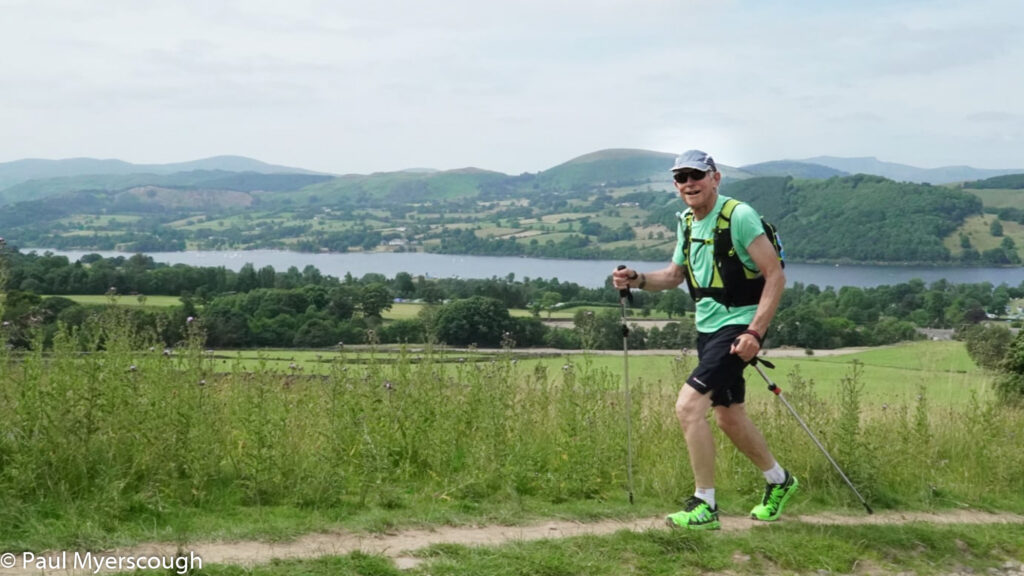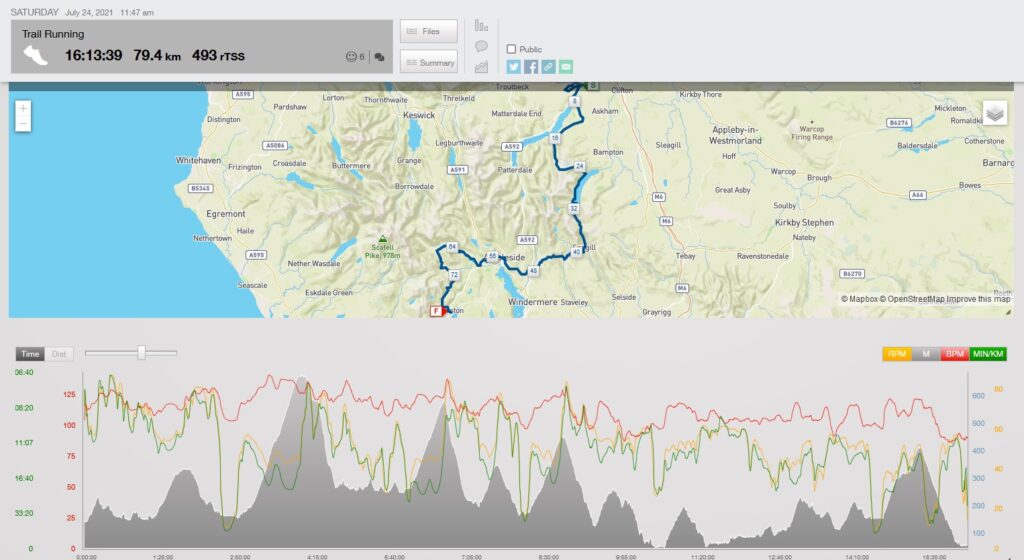The Lakeland 50 is for walkers as well as runners. I entered in 2019 for a walking challenge. But I soon realised that I wanted to run at least part of the course if possible and decided to check out my general capability. It seemed there were no obstacles, so I started running regularly.
Preparation
I reviewed the results from previous years and realised that many people stop entering LL50 in their 60s. At 69 I would be the oldest in the v60 category and some of the youngsters in their early 60s were doing times that were impossible for me. The following year I’d be in the v70 group which had just 2 or 3 entrants. Here I could be a bit more competitive and, with training, maybe do well!
Injury prevented me starting that in 2019, so I put name down for 2020. Further injury interfered with training again. The injuries were not so serious – I could for example cycle my longest ever ride on the day of the 2019 ll50, and with my second injury there was no problem doing some mountain walking and backpacking. I needed to recover properly however to avoid the problems getting worse and to be fit for running. It seems, for me, recovery time is around 10 months.
I was pretty much recovered by the time the Lakeland 50 started at the end of July in 2021 but there had been no time for any serious training for the event. Fortunately my backpacking trip across Scotland (see TGOC story) must have helped with overall aerobic fitness and capability for uphill walking.
The entrants list for 2021 had exactly 20 entrants in the v70 category. Although many more than in previous years this was actually very heartening to learn – I was not alone in believe this is a reasonable thing to do!
I was careful about my activity in the 4 weeks prior to the race – a couple of gentle short runs and one long walk (40+ km) seemed enough. The two days prior to the race I tried to ensure I slept well.
I had no idea how I would feel during or after the event.
On the day
On the day the weather was near-perfect with a recent very hot spell ending the night before.
The event was organised well with helpful and responsive people at all the checkpoints. There was a problem at Howtown however. This first checkpoint had people queuing. After 20 minutes or so I was told the queue was for water and we could bypass the line for registration alone; I decided to fill up in the stream ahead. Some people later claimed to have queued for 45 minutes.
Around the half-way mark something happened to my right knee. This became painful on the downhill; these were the parts I planned to run if possible so my overall pace slowed. I was passing people on the uphill only to be overtaken by them on the downhill parts.
I ended the race 2nd in the v70 category at around 16 hours however – feeling fine in every way.
Analysis
My running watch provided interesting information, worth some analysis.
- The course. The tracking breaks the trail down into 80 1km segments. The recording shows both elevation loss and elevation gain for each segment. There are not many segments with both a large amount of uphill and a large amount of downhill. So, although 1km segments seem long in mountainous terrain for units of analysis, in this case probably not much would be gained by a finer grained appraisal.
- There are 46 km segments with an net elevation drop or a gain of 4m or less – ‘level or downhill’ segments; leaving 34 km segments with an elevation gain of more than 4m – ‘uphill’ segments. An accepted strategy is to walk uphill and run downhill. On this basis I could expect to move faster on 46 of those segments.
- Running & Walking. There are various ways to recognise running, but for the sake of this analysis I decided to look at segments with a time of less than 9 minutes – although I rarely run this slowly, I know I almost never walk faster than 9 min/km.
- There are 20km with a pace faster than 9 min / km
- There are a further 26km with a downhill profile where I might be expected to run.
- Before the halfway-point a problem occurred with my right knee which gave pain on the downhill.
- I was aware that I was walking faster than many people particularly later-on and on uphill sections. My ‘normal’ walking pace at home is 10-13 min/km; this speed seemed to be typical for the whole 80km with little or no drop-off through fatigue.
- Checkpoints. It is easy to waste time at checkpoints. The running watch does not highlight them, but they can be identified by comparing the total time to the moving time for each segment. The segments with checkpoints included 27, 23, 20, 19, 13, 29 minutes, with a total vs moving time difference of 19, 5, 10, 12, 2, 14 minutes. It is hard to imagine reducing this total by very much.
- Heartrate. This is often used as a proxy for effort. Heart rate zones are a key factor in training, but setting them without clear indication of how they tie in to the ADP / ATP metabolic processes is a bit of a black art. Early in the year most of my runs were in what I set as zone 2 or 3. looking at my training diary there is one run with a much younger colleague with 76% in my zone 4. For the Lakeland 50 my time splits:- 33% in zone 1, 34% in zone 2, 22% in zone 3, and 8% in zone 4. This seems to indicate a relatively low level of effort; this also suggests I could expect a quick and easy recovery!
- Other competitors. What is the optimum way to approach the run? It is difficult to draw general conclusions, although it is said that many who drop out start too fast. The results give the splits by checkpoint for each of the contestants, but downloading the results for analysis is made difficult by the way which they are published.
- I compared the 55 finishers in V60 and V70 categories. Looking at the 10 fastest to Coniston it is remarkable to see that all except 1 were in the first 10 at Mardale Head (checkpoint 2). For those in position 11-20, 2 were in the following group at Mardale Head, while 1 person was in the leader group. Similarly among those finishing 21-30 2 had moved up from the following group, and one person had dropped back. It looks like there is little movement in position after Mardale Head which at 33km is just over 40% of the total distance. The figures were a lot more variable at the first checkpoint Howtown but, as I already mentioned, the operation there was a bit chaotic with racers queuing for up to 40 minutes so analysis here is not really valid. It seems most of these competitors had settled into a pace they could maintain before they reached this second checkpoint.
- Although 2nd in the V70s, my ranking in this wider group was 24 at Mardale Head and 19 at the finish. I might have moved up the ranking a little more without my downhill running problem which became apparent near Mardale.
- Looking at the V70 group. The winner was 3.5 hours ahead of me; the person who came 3rd was 40 minutes behind. The differences in times between me and the V70 leader show he was faster than me over every section. The biggest gains however were on the parts with longish running sections – 5 sections with gains of more than 30 minutes. The gains over rough ground and uphill was less – 3 sections of + 12 mins.
- And, since then? Immediately after the event I felt physically fine – a little sleep-deprived but otherwise ready to continue with everyday life as before. I waited a week or so before running and then headed off on one of my local 5k or 10k circuits. I expected it to be easy, but on the contrary it seemed more difficult that before. Participating in this long run did not really help my training, it seems and I have to go back to the business of establishing a aerobic base as if the Lakeland 50 never happened!


Interesting stuff, but it rather sent me down a rabbit hole!
Back in March, before our first recce of the route, I pored over the map and allocated sections as ‘steep up’, ‘steep down’ and ‘runnable’, allocating assumed paces to each of those sections. That resulted in a course time of 15 hours, excluding stops.
During my training runs on the route, I established (as was to be expected) that some sections that looked runnable on the map weren’t, but that most of what I’d assessed as ‘steep downs’ were, in fact, perfectly runnable and that I could easily maintain a faster pace than assumed on the ‘steep ups’ too.
Reading your post reminded me that I’d not added the timings from the actual event to my spreadsheet, so I’ve just gone through my downloaded GPX file from the official event tracker. Interestingly, even though we ended up barely running at all, it turns out our moving time was only just over an hour slower than the figure I’d originally come up with back in March. What really scuppered us, in spite of good intentions, was the time spent not moving (which wasn’t entirely at check points). I’m sure there will be some lessons to be learnt there for Mick to apply if he gets a place next year.
Good luck in the draw!